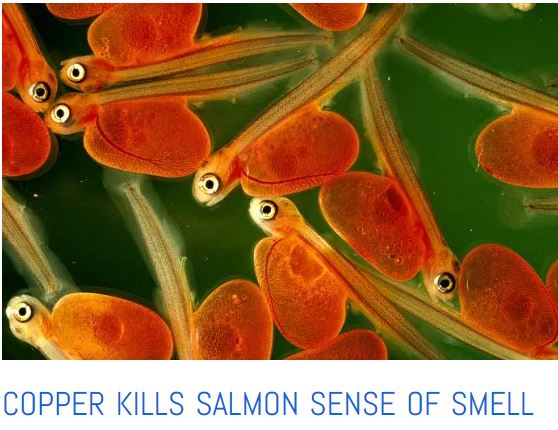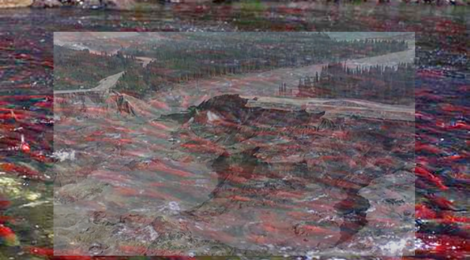
FISHPOCALYPSE NOW EPISODE 3 read the review
Scarlet Sockeye Salmon Aren’t Exactly Canaries
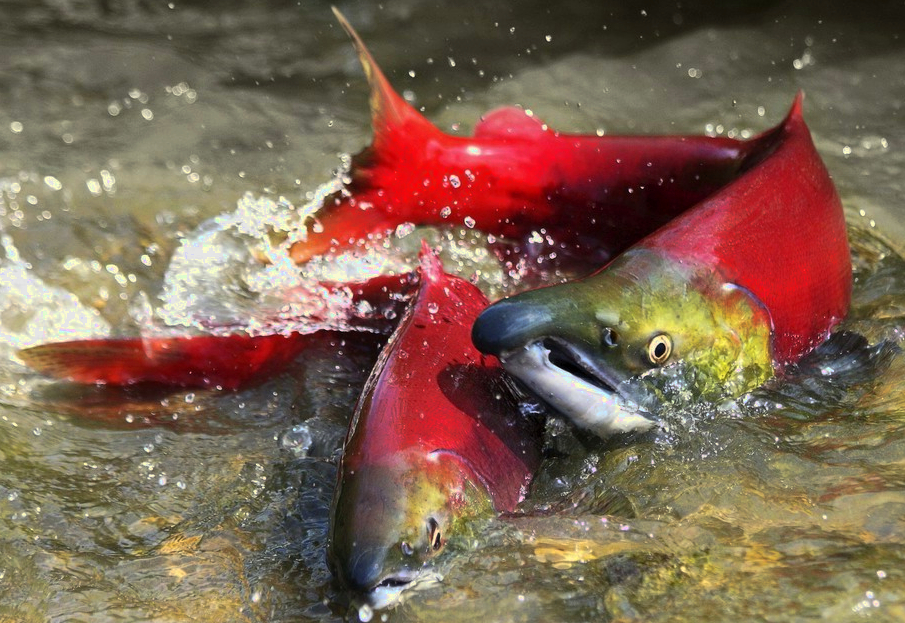
But they can and do serve the same purpose as living indicators of the health of their and our environment.
In August of 2014 the world’s largest spill of toxic mine waste took place in remote British Columbia.
The spill went into a lake that is the nursery for one of the most important populations of salmon left in the world.
Perhaps you have been following my series of reports on the deadly Mt. Polley Mine disaster which began as my report FISHPOCALYPSE NOW, that was followed by a second report FISHPOCALYPSE THE SEQUEL, alas that largest spill of toxic mine waste in the history of the world and its impacts on the environment and the iconic Sockeye Salmon hasn’t all washed and diluted into nothing yet, it’s a spill that keeps on killing as Fishpocalypse 3 tells.
Provincial Absolution
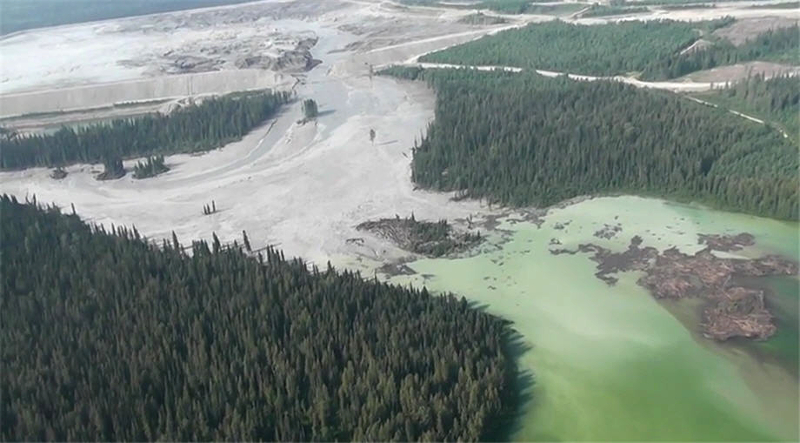
Mt. Polley Mine and Quesnel Lake Mine Waste and Sockeye Salmon Disaster of August 2014. click to read more
This month the Province of British Columbia has effectively absolved the mining company of responsibility for the world’s largest mine waste spill by declaring that the province will not seek to impose penalties or fines upon the company. Surely the provincial forgiveness is not merely generosity but also is a form of self-defense due to the fact that the mine was operating under the engineering supervision and direction of the Provincial Mines Inspectors who clearly missed or ignored the undeniable signs of imminent dam failure that led to the spill. No court would refuse an appeal by the company that might show evidence that the inspectors failed in their duty.
From the fish point of view
Ever since the spill there has been a determined effort by many to cast doubt on the damage to the environment and especially to fisheries that resulted from the disaster. Given that the spill went directly into one of the most iconic and vital salmon environment there never could be any question as to whether the spill caused massive harm, the only question is whether that harm is truly horrific.
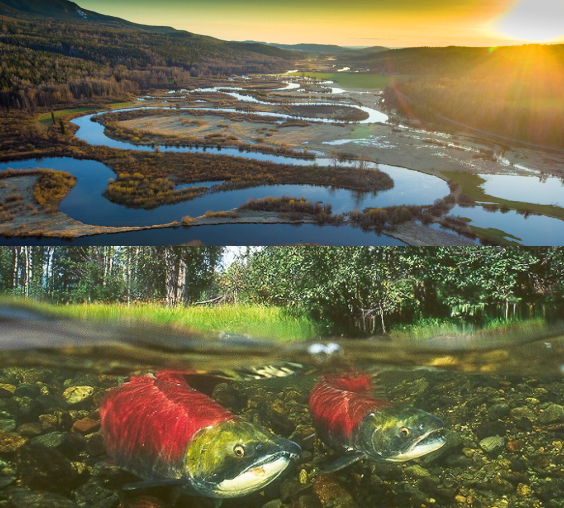
Pristine Horsefly River spawning channels can’t serve their fish if the fish are poisoned downstream – click to enlarge
As environmental indicators, ‘canaries in the coal mine’, the Sockeye Salmon of the watershed of this mine waste disaster are tragically perfect. Sockeye have a 4 year life cycle, they spend 2 years in the fresh water and then 2 years out at sea. Their freshwater life is all about pristine water quality that they require, and indeed in the high northern lakes of British Columbia one finds just such pristine conditions, until now.
Sockeye adults swim in from the ocean at just this time of year and battle the currents upstream to find the spawning gravel beds where their parents laid the eggs from which they hatched 4 years ago. The eggs are mixed into the gravel of small streams and rivers and over the course of about 6 months the eggs hatch and the hatchling salmon, known as fry, slowly grow mostly under the frozen surface of their native streams over the winter.
In the spring the tiny baby salmon no bigger than a tiny guppy emerge from the gravel and swim downstream into Quesnel Lake as is the case here. There in the lake they live in vast numbers of tiny minnows feeding on microscopic plankton until their second spring. At that time they swim out of the lake and down the mighty rivers into the North Pacific ocean. In the ocean they live amongst vast numbers of predators and most will not survive. But those that do swim back to spawn at age 4.
Triple Whammy hits the fish
At the time of the catastrophic spill the Sockeye adults from 4 years earlier were just leaving the sea and entering the Fraser River near Vancouver on their journey to end their lives by spawning hundreds of miles upstream. The eggs they lovingly dug into the gravels of their spawning beds would be their legacy. Upon spawning the adults die and their bodies, still full of nutrients would slowly decay in the stream, providing a sort of salmon compost to enrich the stream and lakes below growing a rich crop of plankton and aquatic insects to feed their soon to hatch babies.
In August of 2014 the mine waste prevented all but a few of the returning adult salmon from making it up river to spawn — Whammy #1
A few months before the mine spill a generation of baby Sockeye salmon had matured into smolts, the name for baby salmon migrating to the sea. Those smolts form a chemical memory of their native streams and that memory, that smell, will lead them back to spawn in two years time.
The smolts leaving in the spring of 2014 had imprinted on a pure pristine smell of their watershed and spawning beds that was now made utterly different by the largest mine waste spill of all time.
There were dire predictions at the time of the spill that the smolts of 2014 would never find, smell, their way home in the summer/fall of 2016. That proved to be a horrible fact as the return of salmon to the Horsefly River spawning grounds in 2016 was lowest in history. Instead of 100,000 fish returning barely 3,000 found their way to their chapel of life to consummate their sacred duty. Whammy #2

At the same time that the August 2014 mine spill killed and prevented the returning adult sockeye from consummating their lives to keep their solemn covenant with sustain nature that spill immediately poisoned Quesnel Lake. There an earlier generation of young Sockeye were swimming, feeding, and growing into smolts (young salmon ready to go to sea) in what should have been pure pristine waters. We don’t know the scope of the chemical holocaust on those lake dwelling baby Sockeye smolts and other lake fish. But we do know that the many would migrate out of the lake in the spring of 2015, off to spend their lives grazing on their North Pacific salmon pasture with a destiny to return in 2017.
Will this year reveal Whammy # 3? The news from the fisheries managers is truly dismal. Not only the Sockeye salmon in the direct path of the devastating world’s largest toxic mine spill seem to have gone missing but more. The entire Fraser River Sockeye salmon run is in dire shape. It looks to be the smallest return in all of history. A devastating blow to all of Nature that lives in partnership with the salmon.
From my report 4 August 2014: A massive breach of the toxic waste containment lake dam at a gold mine has sent millions of cubic meters, billion gallons, of toxic mine waste into Quesnel lake and regional waterways. This massive spill is just a few km from where one of the largest runs of sockeye salmon in the world along would normally be swimming into the lake alongside the town of Likely, BC.
Update 4 Sept 2014: The amount of mine waste in the spill has now been reported by the company to be far larger than the original report. Now 25 million cubic meters (6.6 billion gallons) of waste are reported to have spilled through the breached waste containment dam, 78% more than the original report!
At 6.6 billion gallons he spill contained more than 6,000 times the waste contained in the infamous Love Canal which held a mere 1 million gallons of waste! The Exxon Valdez spilled a paltry11 million gallons of oil into Alaska’s coastal waters in 1989. This Canadian spill is 25 times larger than the similar and deadly spill of 1 million cubic meters of toxic waste from a mine in Hungary in 2010 into a tributary to the Danube River.
Preliminary reports cite a toxic stew of heavy metals and arsenic are in the spill. As those heavy metals mix into the more acidic waters of Quesnel lake and river, and the Fraser river further downstream, those dangerous metals will be mobilized and become even more dangerous. Spills of this magnitude often take decades to stop the toxic effects and mitigate the damage to the environment. It’s likely this is the most pristine, valuable, and sensitive environment ever subjected to such a disaster.









